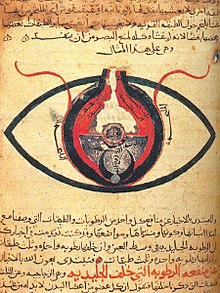Ophthalmology in the medieval Islamic world
This article needs additional citations for verification. (December 2007) |

Muslim physicians described such conditions as pannus, glaucoma (described as ‘headache of the pupil’), phlyctenulae, and operations on the conjunctiva. They were the first to use the words 'retina' and 'cataract'.
Education and history
To become a practitioner, there was no one fixed method or path of training. There was even no formal specialization in the different branches of medicine, as might be expected. But some students did eventually approximate to a specialist by acquiring proficiency in the treatment of certain diseases or in the use of certain drugs.
Nevertheless, it was standard and necessary to learn and understand the works and legacy of predecessors. Among those one can mention, The alteration of the eye by
Cataract extraction
The next major landmark text on ophthalmology was the Choice of Eye Diseases written in Egypt by the Iraqi Ammar ibn Ali al-Mawsili[1] who attempted the earliest extraction of cataracts using suction. He invented a hollow metallic syringe, which he applied through the sclerotic and successfully extracted the cataracts through suction.[citation needed] He wrote the following on his invention:
Then I constructed the hollow needle, but I did not operate with it on anybody at all, before I came to Tiberias. There came a man for an operation who told me: Do as you like with me, only I cannot lie on my back. Then I operated on him with the hollow needle and extracted the cataract; and he saw immediately and did not need to lie, but slept as he liked. Only I bandaged his eye for seven days. With this needle nobody preceded me. I have done many operations with it in Egypt.[3]
Other contributions
| Part of a series on |
| Islamic studies |
|---|
| Jurisprudence |
| Science in medieval times |
|
|
| Arts |
|
|
| Other topics |
| Islamization of knowledge |
In his Colliget, Averroes (1126–1198) was the first to attribute photoreceptor properties to the retina,[6] and he was also the first to suggest that the principal organ of sight might be the arachnoid membrane (aranea). His work led to much discussion in 16th century Europe over whether the principal organ of sight is the traditional Galenic crystalline humour or the Averroist aranea, which in turn led to the discovery that the retina is the principal organ of sight.[7]
Ottoman Empire
In the
See also
- Islamic medicine
- Islamic science
- Islamic Golden Age
- List of Arab scientists and scholars
- List of Iranian scientists and scholars
References
- ISBN 0-226-48233-2
- PMID 27114699.
- ISBN 0-19-514694-8
- ISBN 0-19-514694-8
- ISBN 0-19-514694-8
- ^ Martin-Araguz, A.; Bustamante-Martinez, C.; Fernandez-Armayor, Ajo V.; Moreno-Martinez, J. M. (2002). "Neuroscience in al-Andalus and its influence on medieval scholastic medicine", Revista de neurología 34 (9), p. 877-892.
- ISBN 0-226-48235-9
- ISBN 0-7923-4066-3.
- ISBN 978-90-902140-8-5
Further reading
- Ibn Abi Usaybi’ah, Uyun ul-Inba’ fi Tabaqat ul-Atibba, Cairo 1882.
- Nizami Arudhi, Chahar Maqalah. Gibb Series. London, 1921.
- Zeylessouf-ed-douleh, Matrah ul-anzār. Tabriz, 1916.
- Bar Hebraeus, Historia Dynastiarum, Edward Pococke's edition, Oxford 1663.
- M. Brett, W. Foreman. The Moors: Islam in the west. 1980.
- Cyril Elgood. A Madcap history of Persia and the eastern caliphate : the development of Persian and Arabic medical sciences, from the earliest times until the year A.D. 1932. 1979.
- Casey Wood. Memorandum book of a tenth-century oculist for the use of modern ophthalmologists : a translation of the Tadhkirat of Ali ibn Isa of Baghdad (cir. 940-1010 CE).
